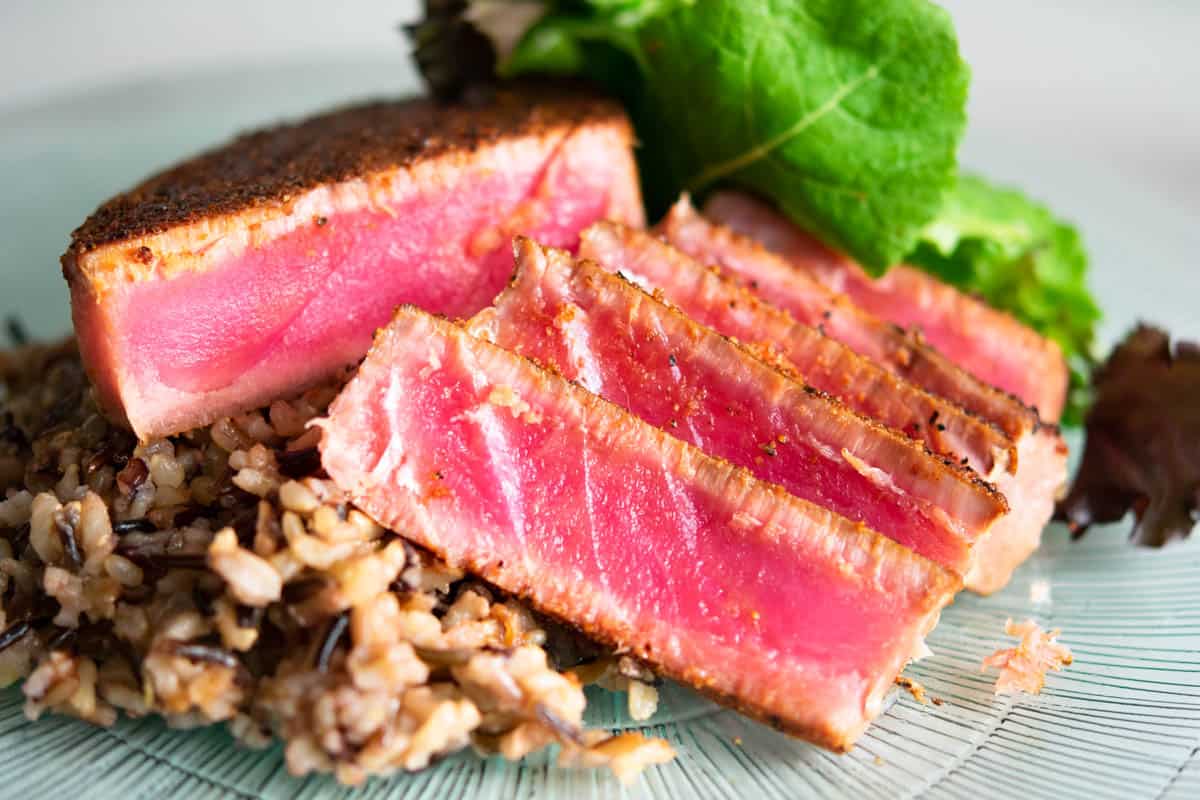Blackened Tuna: Recipe, Benefits, and Cooking Tips
Blackening is a cooking technique developed by Chef Paul Prudhomme in the 1980s. This method became popular in Louisiana cuisine, where it’s often used to prepare various types of fish. The process involves dipping the protein in melted butter, coating it in a mix of spices, and then cooking it in a very hot cast-iron skillet. The high heat creates a dark, flavorful crust on the outside, which contrasts with the tender interior.
Key Ingredients Used in Blackening Tuna
Blackened tuna features a combination of fresh tuna and a robust spice mix. The following list of ingredients highlights key components:
- Fresh Tuna Steaks: High-quality, fresh tuna steaks ensure the best texture and flavor.
- Butter: Melted butter helps the spices adhere and promotes the formation of a rich crust.
- Spice Mix: Common spices include paprika, cayenne pepper, garlic powder, onion powder, thyme, and oregano. This blend provides the signature bold flavor.
- Salt: Enhances the overall taste and balances the spice mix.
- Pepper: Adds a touch of heat and complements the other spices.
These ingredients work together to create the distinctive taste and appearance of blackened tuna.
How to Prepare Blackened Tuna
Choosing the Right Tuna Cut
Selecting the right tuna cut is vital for blackened tuna. Tuna steaks, usually from yellowfin or ahi tuna, are ideal due to their firm texture and rich flavor. Each steak should be about 1 to 1.5 inches thick. Thicker cuts ensure the tuna stays moist inside while forming a perfect crust outside. Verify the tuna is fresh; it should have a deep red color and no fishy odor.
- Preheat Skillet: Preheat a cast-iron skillet over medium-high heat until it’s smoking hot. A well-heated skillet is necessary for creating the signature blackened crust.
- Prepare Tuna Steaks: Pat the tuna steaks dry with paper towels. Then, coat each steak evenly with melted butter. This layer helps the spice mix adhere and contributes to the crispy crust.
- Coat with Spice Mix: Mix together paprika, cayenne pepper, garlic powder, onion powder, thyme, oregano, salt, and pepper. Generously coat each side of the buttered tuna steaks with the spice mix.
- Cook Tuna Steaks: Place the seasoned tuna steaks in the hot skillet. Cook each side for about 2 to 3 minutes, depending on thickness. The outside will turn black, creating the crust while the center remains medium-rare.
- Rest and Serve: Allow the tuna steaks to rest for a couple of minutes after cooking. This helps the juices redistribute, ensuring every bite is flavorful and moist. Serve immediately with your preferred accompaniments.
Serving Suggestions for Blackened Tuna
Accompaniments and Side Dishes
Pair blackened tuna with fresh, crisp vegetables that complement its bold flavors. Consider serving it with steamed asparagus, grilled zucchini, or a mixed green salad. Quinoa or wild rice provide excellent bases that absorb the juices from the tuna, enhancing the dish. For a more decadent option, serve blackened tuna with creamy mashed potatoes or a baked sweet potato. Each side dish enhances the tuna’s spicy, charred crust while balancing its tender, medium-rare center.
Sauce Pairings
Choose sauces that contrast and elevate the flavor profile of blackened tuna. A tangy citrus vinaigrette or a spicy mango salsa provides a refreshing counterpoint. Creamy sauces like tartar sauce or a lemon-dill aioli add richness and depth. For an Asian-inspired twist, try a ginger soy dressing or wasabi mayo. Each sauce pairs well with the smoky, spicy crust of the tuna, enhancing its overall taste and complexity.
Nutritional Overview of Blackened Tuna
Health Benefits
Blackened tuna offers various health benefits due to its high nutritional content. Tuna is rich in protein, providing about 24 grams per 100 grams of cooked fish. This high protein content supports muscle repair and growth.
Tuna is an excellent source of omega-3 fatty acids, with around 0.5 grams per 100 grams. Omega-3s are crucial for heart health as they help reduce inflammation, lower blood pressure, and decrease the risk of heart disease. Additionally, tuna contains vitamins B12 and D, which support brain function and calcium absorption, respectively.
Potential Dietary Concerns
Despite its health benefits, consuming blackened tuna comes with potential dietary concerns. Tuna is known to contain mercury, with levels varying based on the species and size. Larger tuna species like ahi often have higher mercury concentrations. Therefore, pregnant women and young children should limit their tuna intake to minimize mercury exposure.
The spice mix used in the blackening process might be high in sodium. If you are on a low-sodium diet, consider adjusting the seasoning to reduce sodium content. Blackened tuna cooked at high temperatures can form heterocyclic amines (HCAs), which are compounds linked to cancer risk. Using moderate heat and reducing char can mitigate this concern.
Conclusion
Blackened tuna offers a delightful blend of flavors and textures that can elevate any meal. By mastering the technique and being mindful of ingredient choices, you can enjoy a dish that’s both delicious and nutritious. Remember to balance the health benefits with potential dietary concerns, especially for those with specific health conditions. With the right approach, blackened tuna can be a standout addition to your culinary repertoire.





